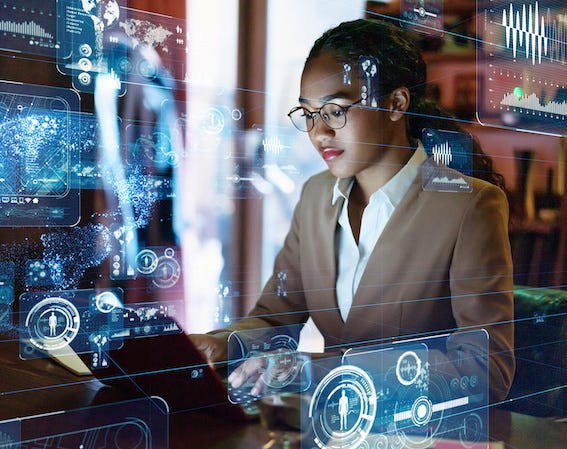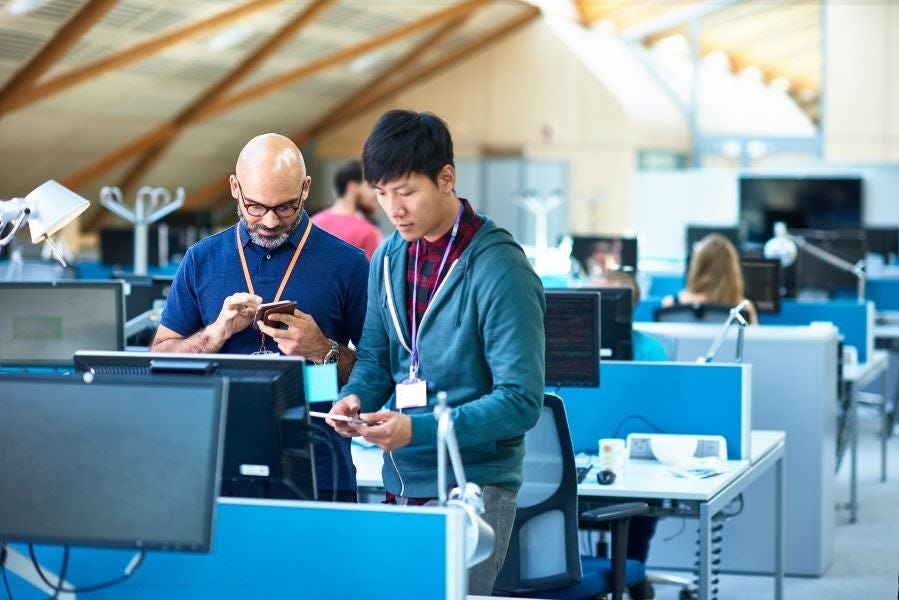Technology, Programming and Datascience Trends of 2022
Metaverse, Web3.0 and evolution of software is blossoming in a digital transformation era.
After curating some of the top trends in A.I. in 2022, I wanted to write more about tech trends from a programming, datascience, retail and technology stand point.
For articles more specifically related to A.I. subscribe here.
Since this is technically a Newsletter and not an article, I will try to formulate some of the trends I’m seeing in a more condensed format.
Furthermore if you want to support my writing which I cannot continue to do without community support you can subscribe here.
So let’s get into it:
1. Web 3.0 Metaverse Jobs
With the narrative around Web 3.0 and the Metaverse both getting some hype in 2022, programming and datascience jobs around the concurrent evolution of both will be strong. From a programming perspective, the growth of the metaverse is considered the evolution of the current internet. Some refer to this as web 3.0.
Currently, the metaverse is just an idea. Check out Nvidia’s Omniverse concept to see how it’s already attracting developer attention.
2. Blockchain is Hot Again
With Bitcoin’s 2nd bull market and becoming the new digital gold, distributed ledger adoption and Web 3.0 really is attracting talent. Blockchain has been a trend for the last decade, but in the 2020s looks poised to becoming more mainstream even with FinTech scaling in market valuation.
Programming languages like Rust are attracting attention of DeFi and Dapp makers.
3. Datascience will be Optimized
Datascience is evolving to be a bigger part of how organizations and firms make decisions based on data. There will be increased demand for data science consultants. Data science training and education is becoming an increasing part of the curriculum in universities. This will be a good time for companies that are developing tools for data science.
4. Work from Home Accelerates
As WFM becomes the new normal, how we work from everywhere either in programming, datascience or technology also changes. The “Great Resignation” of jobs in America is also a shift to this new digital-first reality of the future of work. Digital transformation itself will create new jobs and new roles in a WFM-centric world. Lenovo's research shows that 83% of IT leaders expect at least half of work in the future to happen outside a traditional office.
5. Cloud and Edge computing Intersects with Decentralized Infrastructure
Unlike the public Cloud where we want to have storage, compute power, and AI/ML in a central place (Availability Zone, Region), Edge computing brings the storage, compute power, and AI/ML near the customer. 5G, Web3.0, Cloud sophistication and AI-as-a-Service becoming more mature is a convergence of computing that will stimulate programming, tech and datascience jobs.
6. Cloud and Blockchain Interoperability Improves
As the Cloud and Web 3.0 consolidate, better integration and cross-platform and hybrid-could features arrive. Traditionally once you move your Infrastructure, Storage, and Compute to the Public Cloud provider, you are vendor locked. Many analysts see services that are API compatible with the widespread public cloud Services improving. More Cloud neutrality, greater interoperability and vendor-agnostic features are coming.
7. Ambient Computing Will Mature
5G, IoT, human-hybrid augmentation and Edge computing evolutions will make our world more responsive to us, not just in the Metaverse, but in the real world. It’s not all about escaping into VR or a WFM environment. The Internet of Things (IoT) will continue to mature as device manufacturers refine user inputs. Natural language processing (NLP) and multi-lens enrichment will change the user experience as we know it.
8. The Metaverse and Pandemic Accelerate Gaming
When you hear about Bethesda’s new game Starfield, you get an idea of how gaming is evolving into new worlds. Meanwhile, mobile gaming, Esports, the creator economy around gaming and the evolution of gaming during the pandemic has accelerated the gaming industry as a whole. The games market in 2021 will generate total revenues of $180.3 billion, up +1.4% over last 2020. In the 2020s it will shift even more in a mainstream way.
9. Datascience Tasks become more Automated
For example, Automated Machine Learning, or AutoML, is one of the latest trends that is driving the democratization of data science. A huge part of a data scientist’s job is spent on data cleansing and preparation, and each of these tasks are repetitive and time-consuming. AutoML ensures that these tasks are automated, and it involves building models, creating algorithms and neural networks. AutoML is essentially the process of applying ML models to real-world issues by leveraging automation.
10. Better A.I. and Data Regulation is Coming
There’s an increasing realization that we need to get better at regulating A.I., moderating platforms and improving cybersecurity all around. With AI moving deep into industries such as healthcare, sensitive EMR and patient data cannot be compromised. Data privacy by design will help create a safer approach towards collecting and handling user data while the machine will learn to do it by itself.
11. A.I. as a Service Rapidly Matures
AI as a service is being stimulated by Cloud leaders such as AWS, Azure and Google Cloud. It refers to businesses that offer out-of-the-box AI solutions which allows the clients to implement and scale AI techniques at a low cost. Everyone from ByteDance, Nvidia to OpenAI with Microsoft is doing it better and better each year. Enterprise AI has a good trajectory for the 2020s as well.
The market for AIaaS is expected to reach $43.298 billion by 2026, growing at an incredible CAGR rate of 48.9% during the period of 2021-2026. AIaaS looks extremely promising for 2022 and beyond, we are likely to see a number of businesses leveraging AI with the help of this technology.
12. Developer Activity is Increasing in DeFi & Digital Ledger Ecosystems
Electric Capital found that more than 4,000 developers actively work on Ethereum per month. Meanwhile about 680 developers actively work on Bitcoin per month. Younger rivals to Ethereum are increasing faster but still lag far behind. Polkadot, a rival blockchain platform designed by Ethereum co-founder Gavin Wood, has around 1,500 monthly active developers. Solana and Cosmos, two other promising rivals, have around 1,000 each. NEAR, Avalanche, Cardano, and Tezos all have more than 250 active developers.
13. Cashierless Automated Retail Stores Are Becoming More Common
Amazon, JD.com and others continue to pilot stores that do not require checkout in the traditional sense that reduce customer friction and speed up shopping convenience. Chinese e-commerce giant JD.com has opened two retail stores in the Netherlands that it says will be manned with robots preparing and delivering packages. The “robotic shops” branded Ochama mark JD.com’s first foray into Europe with bricks and mortar locations.
14. Robotic and Drone Delivery Will Improve and Become More Commonplace
Pilots for robotic delivery systems reach L4 autonomy. 2022 will be the year robot delivery finally takes off to become more popular even as drone delivery regulation improves. This could be a big time for robots to enter the workforce in the gig-economy with many new use cases. In January, 2022 it was announced that Serve Robotics, the Postmates spin-off robot department under Uber's wing has introduced its next-generation delivery robots capable of operating without human intervention.
15. The Great Resignation Should Make a Deeper Developer Labor Supply Issue
The shortage of software developers is expected to hit businesses hard in 2022 and perhaps 2023 as well. With people leaving jobs with toxic cultures or who aren’t flexible with WFM or even 4-day work weeks (for instance in indie developer gaming sector), programmers will be in short supply for some companies.
16. Deepfakes Join Misinformation as Serious Problems of Internet Credibility
The internet is about to have a lot more audio and video deepfakes. Deepfake content uses artificial intelligence to manipulate or create content to represent someone else. It’s expected this kind of content will explode in popularity and create confusion as to what is real, what is fake, what is true and what is misinformation. Generative AI and synthetic data will create a less reliable experience of the internet, but also one with more bizarre memes and sub-cultures.
17. Convergence in Technology Colliding with Convergence in the Pressure for Automation
Labor, supply chain and talent shortages along with pressure from the pandemic increase the necessity of companies to automate more.
This pressure of inflation and society in the ‘great resignation’ is colliding with a variety of technology that are maturing and converging together more. AI, the internet of things (IoT), cloud computing, edge-computing and superfast networks like 5G are the cornerstones of digital transformation. This convergence from within and without is what I call the ‘great convergence’ and is happening today.
18. Cloud Native Architecture with Privacy-Enhancing Computation Become Dominant
Cloud-native architectures with privacy computation that secures the processing of personal data in untrusted environments — which is increasingly critical due to evolving privacy and data protection laws as well as growing consumer concerns becomes dominant.
Cloud-native platforms are technologies that allow you to build new application architectures that are resilient, elastic and agile — enabling you to respond to rapid digital change. With digital transformation at the forefront privacy and Cloud-native architectures become the new normal.
19. Date-Based Decision Making
Firms need to adopt a datascience approach to optimizing operations and budgets. This means decision intelligence must permeate their organization where decisions are made based upon data. For example, decision intelligence models each decision as a set of processes, using intelligence and analytics to inform, learn from and refine decisions.
If data is the new oil, to harness that oil means creating a business model with standard operating procedures where datascience based decision intelligence an supports and enhances human decision making and, potentially, automates it through the use of augmented analytics, simulations and AI.
20. Actionable Datascience (ADS)
What is ADS? What use is data in its raw, unstructured, and complex format if you don’t know what to do with it? The emphasis is on actionable data that brings together big data and business processes to help you make the right decisions is taking more attention from how we use datascience in organizations.
ADS augments leaders and managers to make better decisions for the company and business model. From arranging activities/ jobs in the enterprise, streamlining the workflows, and distributing projects between teams, insights from actionable data help you increase the overall efficiency of the business.
21. Metaverse Anticipation Hype will Create New Jobs
New job creation will be taking place inside the metaverse in 2022, from developers working on gaming and NFT transactions for luxury brands and social media platforms, to gamers monetizing their skills. What’s exciting is that the venture capital community will continue to make investments that bridge the world of gaming and the metaverse economy.
Simultaneously a. new global infrastructure based on massive computing power needs should support leading chipmakers like Nvidia and Intel. Apple Says it’s VR/AR product is likely to launch in 2023 and not in 2022. The Metaverse will create thousands of new jobs around new platforms, VR mods and where Web 3.0 intersects with the Metaverse.
If this article is popular and was well read, I will consider extending this list of technology trends. If you enjoyed it, give it a like (a heart) and I’ll know.
If you appreciate my articles please consider supporting. You can help me also by sharing this article.
Thanks for reading!




